Architectural Wonders: The Ultimate Guide to Must-See Buildings in Paris
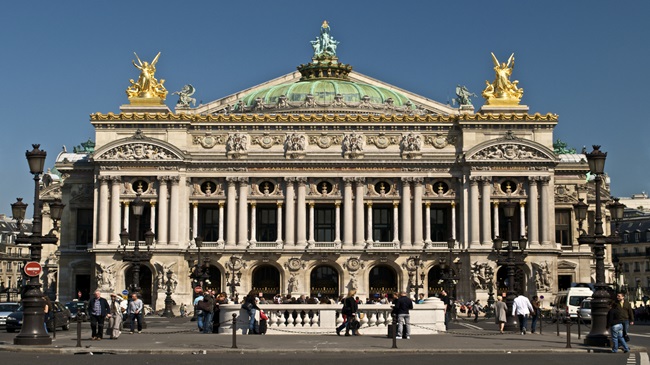

No other city’s skyline tells the story of its history better than that of Paris. From its early beginnings as a Roman colony on the Île de la Cité, to its medieval fortresses, magnificent Gothic cathedrals, classic Renaissance châteaux, homogeneous Haussmann buildings, and myriad progressive contemporary designs, each historical era reflects past cultures reminding us of who we were, who we are, and who we might be again. A visit to some of the most emblematic architecture in Paris will allow us to discover why the city is without equal.
Gallo-Roman Period (1-486 AD)
Arènes de Lutèce
280AD
49 Rue Monge, 5th arrondissement
Original Architect: Unknown
Amphitheater that held up to 15,000 spectators for gladiatorial contests.
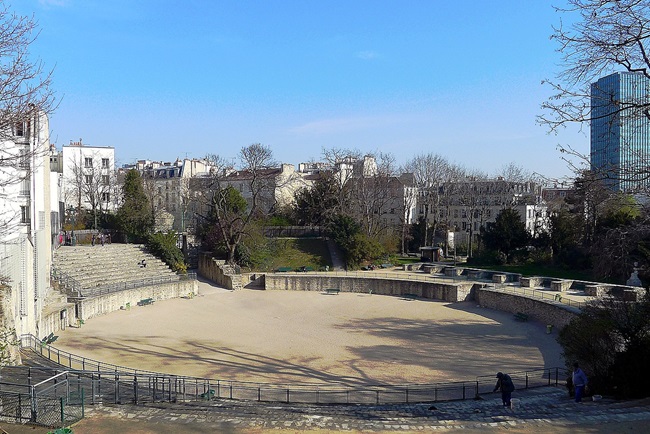
The Arènes de Lutèce, Photo Credit: Mbzt/Wikimedia Commons
Thermes de Cluny
1st and 2nd century AD
28 Rue du Sommerard, 5th arrondissement
Original Architect: Unknown
Restoration Architect: Albert Lenoir, 1838-1843
A Gallo-Roman, thermal public bath complex part of the Musée de Cluny, now the Musée-National du Moyen Âge.
View this post on Instagram
Romanesque Period (990-1160)
Abbaye de Saint-Germain-des-Prés
Constructed in 558 and destroyed by the Vikings.
3 Place Saint-Germain-des-Prés, 6th arrondissement
Original Architect: Unknown.
First Reconstruction Architect: Abbot Morard in 990.
Second Reconstruction Architect: Pierre de Montreuil, 13th century.
Demolished after the French Revolution.
Third Reconstruction Architect: Victor Baltard, 1848-1853, famous for designing Les Halles.
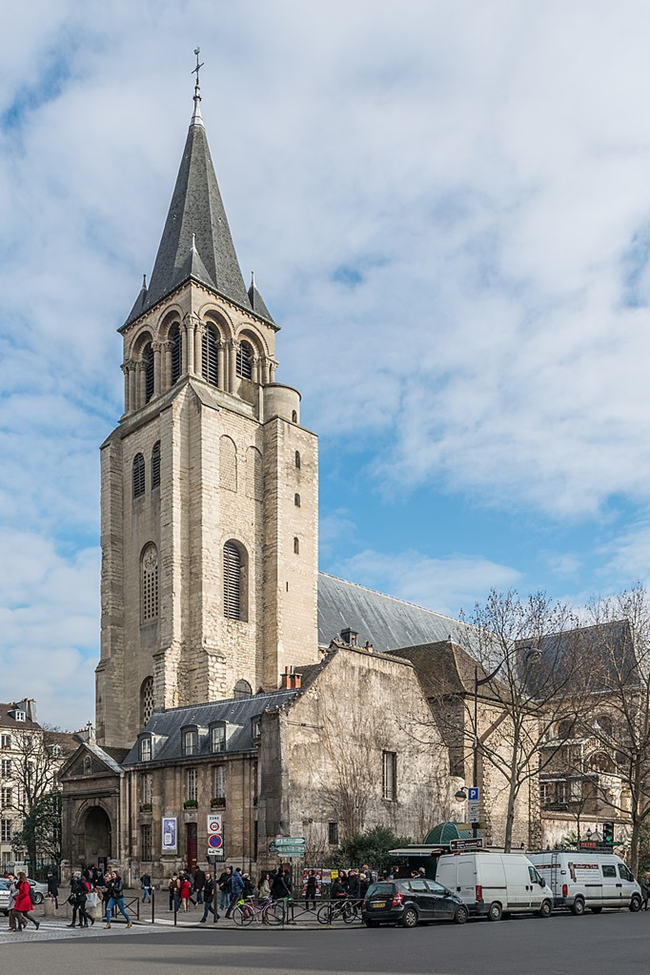
The Abbey of Saint-Germain-des-Prés in the 6th arrondissement of Paris. Photo: DXR/Wikimedia Commons
Basilique Saint Denis
5th century
1 Rue de la Legion d’Honneur, 93200 Saint-Denis
Original Architect: Unknown.
Architectural Supervisor: Abbé Suger, 1135-1144.
First Restoration Architect: Pierre de Montreuil, 13th century.
The St Denis Basilica is considered the birthplace of French Gothic style. It was the burial site for over 70 royal tombs from the 10-18th century. After the French Revolution all of the tombs were plundered and the remains tossed into a mass grave. During the Restoration (1814-1830) all of the identifiable remains were placed in an ossuary. In 1813, Napoleon I commissioned the architect François Debret to restore the building, followed by the 1846 restoration by the architect, Eugène-Viollet-le-Duc.
View this post on Instagram
Medieval Period (1100-1526)
Louvre Medieval
1190 – 1202
Original address: What is now the southwest quadrant of the Cour Carrée, 1st arrondissement.
Chateau Fort: Medieval military fortress to protect Paris against invasions with a 98-foot tall keep, and a moat.
1364 -1380
Renovation architect: Raymond du Temple.
The fort was slowly rebuilt to become a palace by the architect, Raymond du Temple

The remains of the medieval Louvre. Photo credit: Tangopaso / Wikimedia commons
Sainte Chapelle
1242 -1248
1 Boulevard du Palais, 4th arrondissement
One of the best examples late Gothic architecture with the most extensive collection of 13th century stained glass in the world. St. Chapelle is part of the original complex, the Palais de la Cité, built by Charlemagne between 793-813, which includes La Conciergerie, the former courthouse and prison (its most famous prisoner was Marie Antoinette) during the French Revolution.
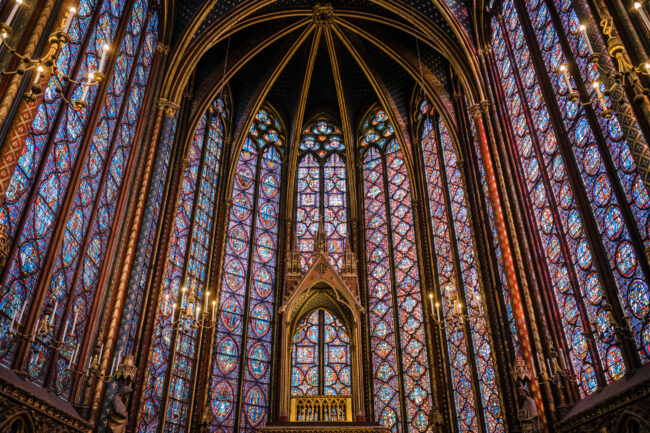
The apse of the upper chapel, Sainte Chapelle. Photo credit: Oldmanisold / Wikimedia commons
Hotel de Ville
1357
Place de l’Hôtel de Ville, 4th arrondissement
Original Architect: Unknown
Known as the House of Pillars, Maison aux Piliers.
First Restoration Architects: Dominique du Cortone and Pierre Chambiges. 1535
Second Restoration Architects: Étienne-Hippolyte Godde and Jean-Baptists Lesueur. 1835
Tried restoration Architects: Théodore Ballu and Édouard Desperthes. 1873-1892
Built in many different eras representing many different architectural styles. The building is the official office of the mayor of Paris and the local government.
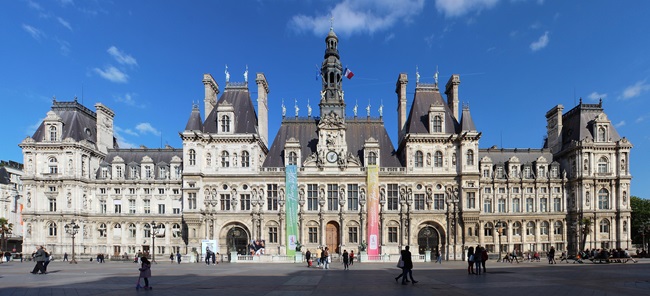
Main facade of Paris City Hall. Photo credit: Chabe01/ Wikimedia Commons
Gothic – (12th – 16th Century)
1163-1345
6 Parvis Notre Dame, Île de la Cité, 4th arrondissement
Medieval Construction Architects: Jean de Chelles, Pierre de Montreuil, and Pierre de Chelles.
19th Century Renovation Architects: Jean-Baptiste Lassus, and Eugène-Viollet-le-Duc.
21st Century Reconstruction Architects: Philippe Villeneuve and Rémi Fromont
Perhaps the most famous Gothic cathedral in the world instantly recognizable for its ribbed vaults, gargoyles, flying buttresses, and beautiful stained glass windows.
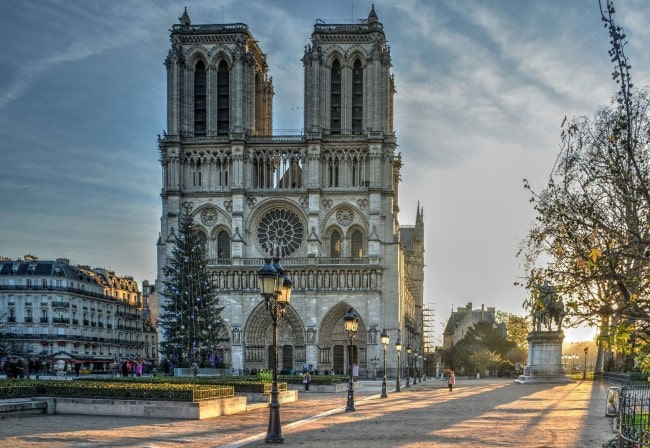
Notre-Dame Cathedral. Photo: LeifLinding, Pixabay
Tour Saint-Jacques
1509-1523
Square de la Tour Saint-Jacques, 4th arrondissement
Formerly part of the Saint-Jacques-de-la-Boucherie church, it is the only section left standing after the rest was demolished during the French Revolution, a metaphorical exclamation point in the Marais district.
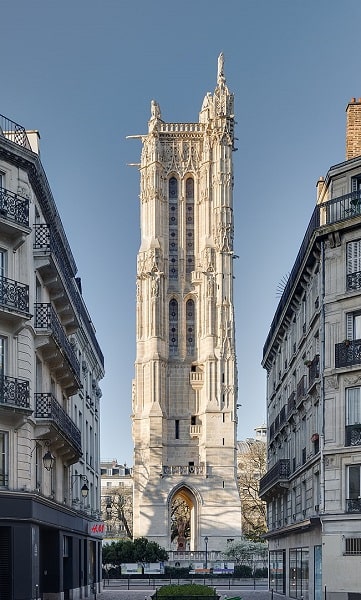
Saint-Jacques Tower. Wikimedia commons
Renaissance – (1515-1643)
1546
Louvre Palace (originally the Louvre Fortress)
First Renovation Architects: Pierre Lescot and Louis Métezeau
1654-1853
Second Renovation Architects: Louis Le Vau, Charles Le Brun and Claude Perrault, Francois Mansart, Percier and Fontaine, Louis Visconti, and Hector Lefeu.
The Louvre Palace is one of the finest examples of Renaissance architecture in the world incorporating classical elements such as domes, rectangular windows, arches, columns, and entablatures.
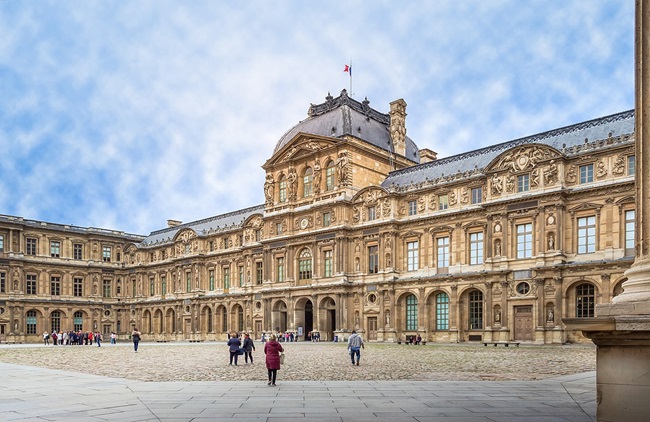
The Louvre Palace. Photo Credit: Ali Sabbagh/ Wikimedia Commons
Palais Royal
1633-1639
8 Rue de Montpensier, 1st arrondissement
Original Architect: Jacques Lemerceier
Renovation Architects: From 1698-1830 – Jacques Lemercier, Jules Hardouin-Mansart, Gilles-Marie Oppenord, Pierre Contant d’Ivry, Pierre-Louis Moreau, Victor Louis, Pierre Fontaine, Charles Percier.
The palace has had more architects then it has had kings and queens residing there, their reigns ending in the late 18th century. Today it serves as the seat of the Ministry of Culture, but is closed to the public. The southern end of the complex is polka-dotted with sculptor Daniel Buren’s 260 black-and-white striped columns, the palace’s outstanding exterior feature since 1986.
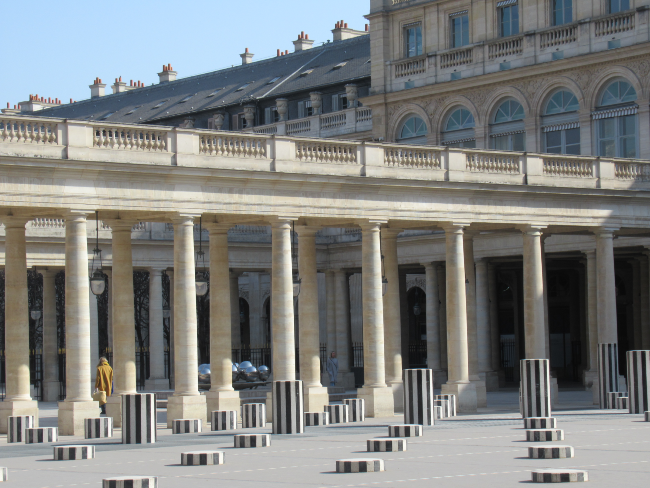
Daniel Buren’s striped columns in the Palais Royal Cour d’Honneur, courtesy of Marian Jones
Neoclassical – (1760-1830)
Panthéon
Pl. du Panthéon, 5th arrondissement
1764-1790
Architects: Jacques-Germain Soufflot
Modeled after the original Pantheon in Rome, Soufflot embellished a classical structure with Gothic detailing. Though it originally served as a church, the building is now a burial place for notable French citizens. Foucault’s Pendulum is housed there, considered to be the “navel of the world” by the Knights Templar.
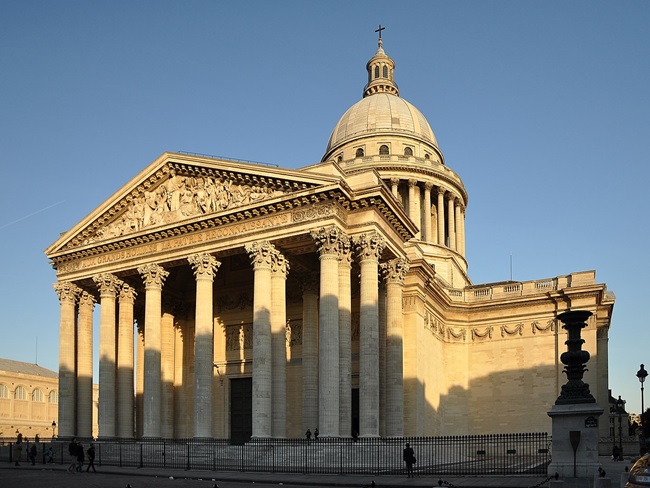
The Panthéon. Photo Credit: Moonik/Wikimedia Commons
Napoleon III and Haussmann Style – ( 1853-1870)
Louvre
1852-1870
8 Rue Sainte-Anne, 1st arrondissement
Renovation Architects: Louis Visconti, and Hector Lefeu.
Napoleon III and Georges-Eugène Haussmann, a French civil servant, modernized Paris by creating wide boulevards, parks, squares, and public buildings. Their renovation transformed Paris into the city we know today. The Louvre became entirely a museum with a new, fortified enclosure, gas lighting system, drinking water supply network, and sewers.
Bibliothèque de l’Institut National d’Histoire de l’Art
1868
Rue de Richelieu-Louvois, 2nd arrondissement
Architect: Henri Labrouste
One of the most elegant examples of an iron vaulted cathedral of books.
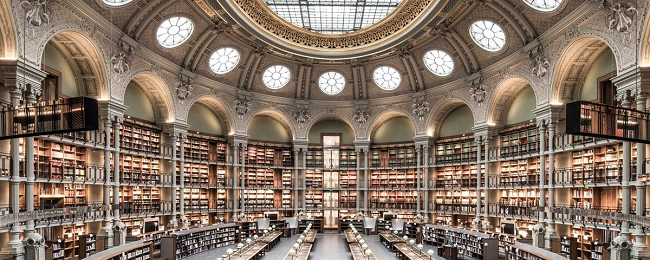
Salle Ovale at the Bibliotheque Nationale Richelieu
Opéra Garnier (Palais Garnier)
1861-1875
Place de l’Opéra, 9th arrondissement
Architect: Charles Garnier
Famously served as the setting of Gaston Leroux’s 1910 novel The Phantom of the Opera. The “Italian-style” auditorium’s ceiling was painted in 1964 by Marc Chagall.
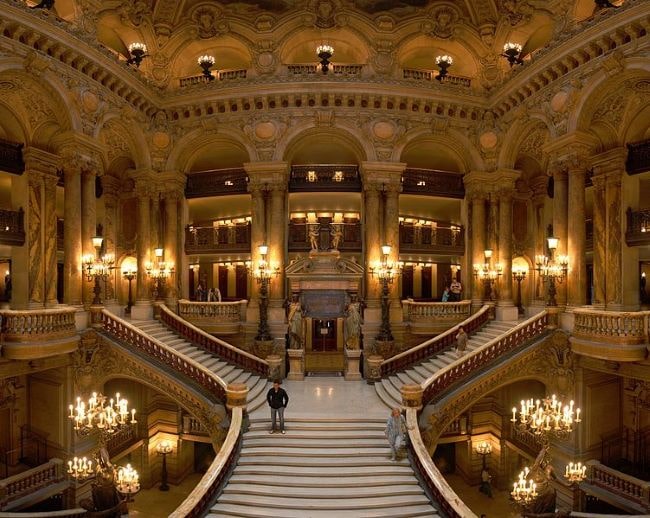
Opera Garnier grand staircase © Benh Lieu Song
The Eiffel Tower
1887-1889
Champ de Mars, 5 Avenue Anatole France, 7th arrondissement
Designed and engineered by Gustave Eiffel with Maurice Koechlin and Émile Nouguier, it was the entrance arch to the 1889 World’s Fair, rising to an impressive height of 1,063 ft. Originally deemed an eyesore, it has become emblematic of Paris.
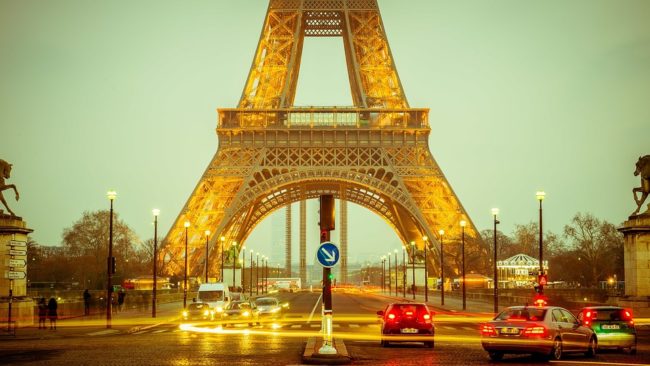
Eiffel Tower. © Pixabay/ skeeze
Sacré Coeur
1875-1914
35 Rue du Chevalier de la Barre, 18th arrondissement
Architect: Paul Abadie
Crowns the highest point in Paris (Montmartre), rising 656 feet above the Seine. This imposing, white-domed basilica was begun in 1875 and continued for 40 years under five different architects: Honoré Daumet, Jean-Charles Laisné, Henri-Pierre-Marie Rauline, Lucien Magne, and Jean-Louis Hulot. Its bell tower is 84 meters high and contains the largest bell in France called the “Savoyarde”, 9.8 feet in diameter, and weighing 8.8 tons.
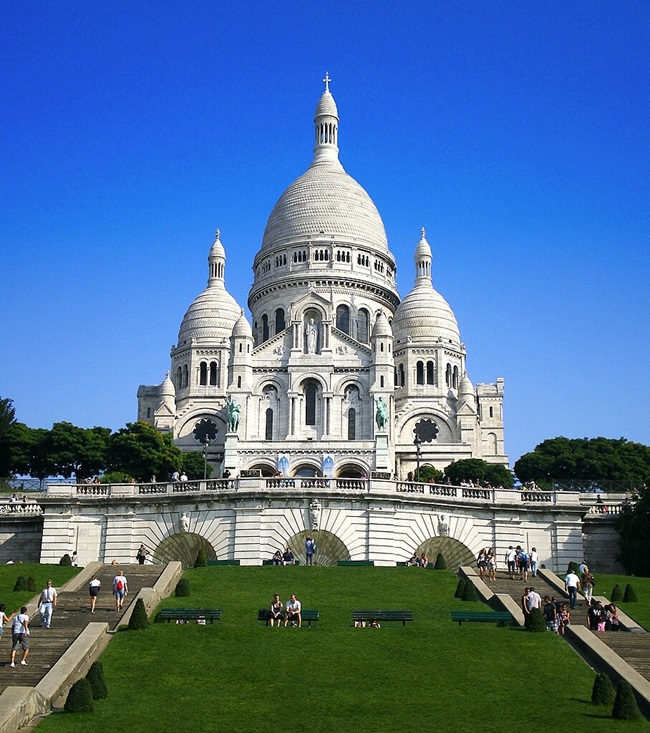
South facade of the Basilique du Sacré-Cœur de Montmartre. Photo Credit: Tonchino
Bourse de Commerce
1574-1584
2 Rue de Viarmes, 1st arrondissement
Original Architect: Jean Bullant
The first building in Paris with a metal frame, blending Catherine de Medici’s Hôtel de la Reine, grain market and stock exchange.
Renovation Architect: Tadao Ando 2021
Hosting painting, photography and sculpture exhibitions under a magnificent glass rotunda.
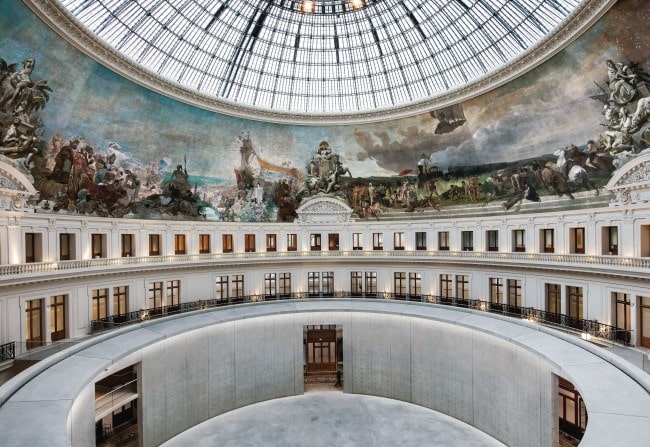
The Bourse de Commerce – Pinault Collection (C) Marc Domage
Art Nouveau – (1890-1910)
Castel Béranger
1912
122 Avenue Mozart, 16th arrondissement
Architect: Hector Guimard
This little building is pure Art Nouveau. Guimard also became known for designing the famous subway entrances of Paris Métro stations, such as the one at Porte Dauphine.
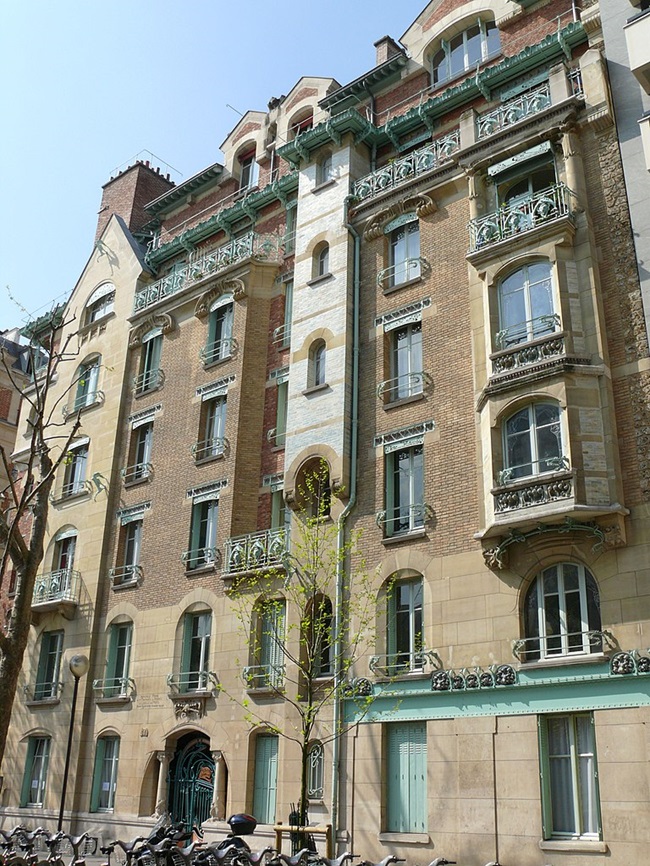
Castel Béranger in Paris. Designed by Hector Guimard. Photo credit: MOSSOT/ Wikimedia Commons
Jules Lavirotte Building
1898-1901
29 Ave. Rapp, 7th arrondissement
One of the most elaborate and beautifully executed Art Nouveau facades in Paris.
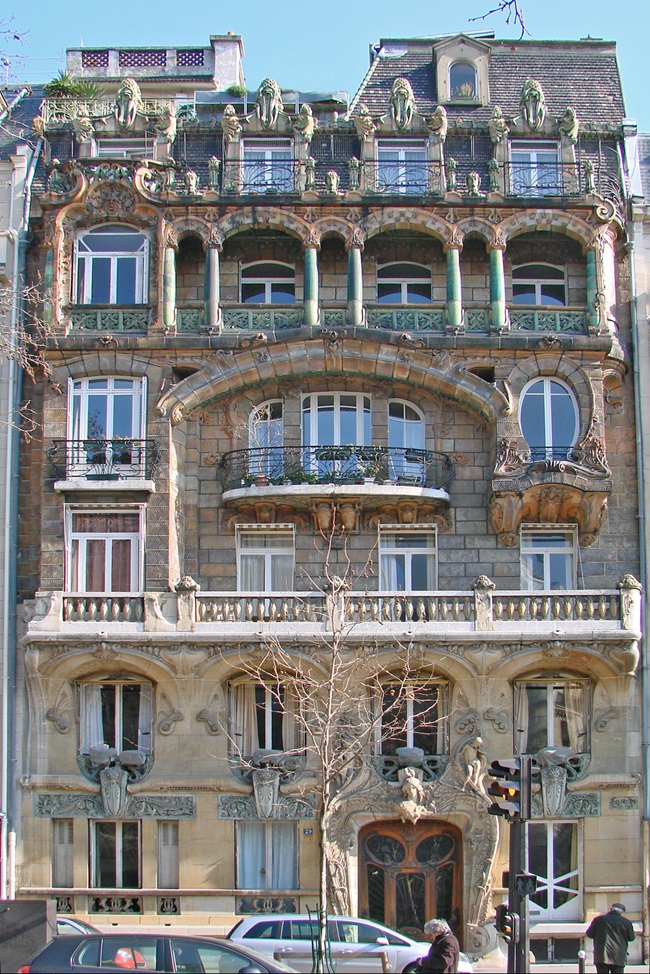
Lavirotte Building, avenue Rapp. Photo Credit: Jean-Pierre Dalbéra/Wikimedia Commons
Musée d’Orsay
1880-1900
Esplanade Valéry Giscard d’Estaing, 7th arrondissement
Architect: Victor Laloux.
Original Gare d’Orsay (Train Station).
Renovation Architect: Gas Aulenti 1981
This unexpectedly resplendent museum houses works of art from 1848 through 1914.
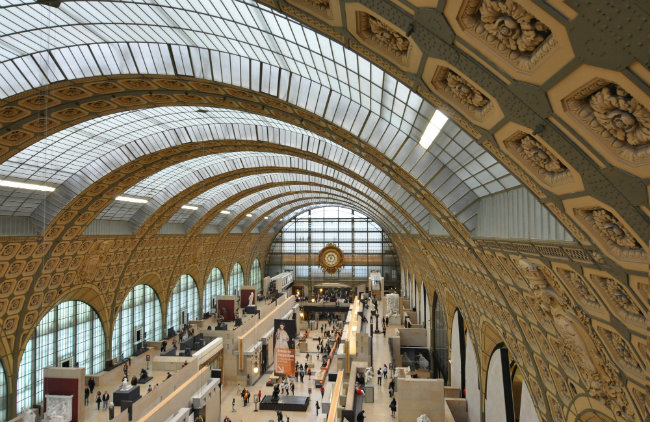
Musée d’Orsay. Photo: Moonik/Wikipedia Commons
Le Train Bleu Café
1902
Gare de Lyon, 12th arrondissement
Architect: Marius Toudoire
One of the most magnificently opulent, Art Nouveau cafés in a Paris train station.
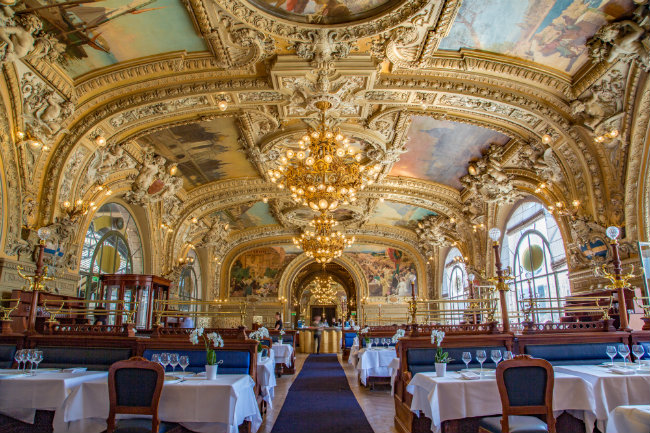
courtesy of Le Train Bleu
Art Déco – (1910-1939)
Théâtre des Champs-Élysées
5 Avenue Montaigne, 8th arrondissement
1911-1913
Architects: Auguste and Gustave Perret
First Art Deco building in Paris distinguished by geometric shapes, and symmetrical lines.

Théâtre des Champs-Élysées. Photo credit: Coldcreation / Wikimedia commons
9 Rue de la Monnaie, 1st arrondissement
1870 Art Nouveau and Art Deco
Original Architects: Frantz Jourdain, Henri Sauvage
Renovation Architects: SANAA + LAGNEAU Architectes 2021
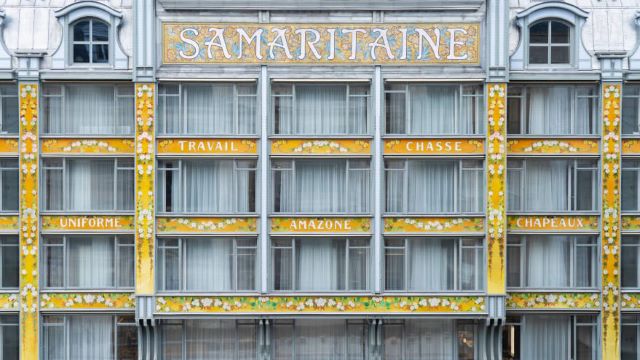
La Samaritaine Facade © We Are Contents
Modern – (1920-1960)
Maison La Roche
1923-1925
8-10 Square du Docteur Blanche, 16th arrondissement
Architects: Le Corbusier and Pierre Jeanneret
Le Corbusier implemented his theory of “ five points of a new architecture ” using pillars, a roof garden, an open floor plan, long windows and open facades.
View this post on Instagram
Villa Savoye
1931
Architect: Le Corbusier
82 Rue de Villiers, 78300 Poissy
One of the most important Modernist constructions of the 20th century. Originally built as a family estate, it now belongs to the French State and is open to the public.
View this post on Instagram
Contemporary – (1960-to present)
Centre Pompidou
19 Rue Beaubourg, 4th arrondissement
1977 – Renzo Piano, Richard Rogers, Gianfranco Franchini
This skeletal, high-tech construction looks like it’s wearing its underwear on the outside of its clothes. It houses over 100,000 works of art from artists such as Matisse, Duchamps, Kahlo, Picasso, Warhol, and Kandinsky, et al.
View this post on Instagram
Louvre Pyramid
1983-1989
Cours Napoléon, 1st arrondissement
Architect: I.M. Pei
An architectural marvel inspired by the Cheops Pyramid in Egypt, the polyhedron covers an area of 10,764 square feet at its base and rises 72 feet above the ground. It’s a 95-ton steel structure, supported by a 105-ton aluminum frame inset with 673 diamond-shaped glass panels which were formed in a specially built oven with sands from the Fontainebleau forest.
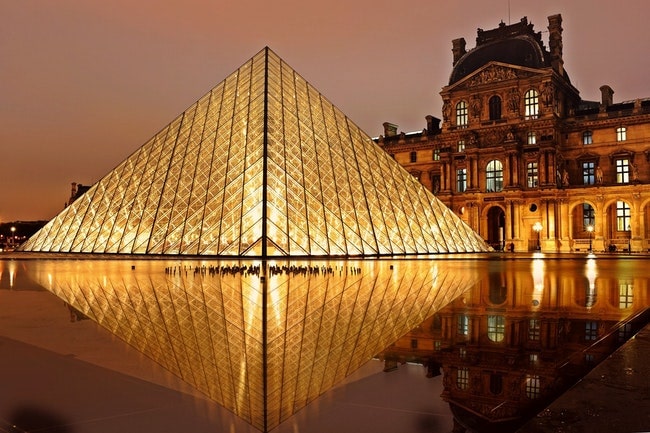
Louvre Pyramid in Paris. © Pixabay at Pexels
Fondation Louis Vuitton
2014
8 Ave. du Mahatma Gandhi, 16th arrondissement
Architect: Frank Gehry
Set between woods and gardens, a futuristic glass ship evocative of 19th century conservatories, with overlapping glass sails representing a transparent vessel to embrace Paris’s dynamic arts and cultural mise-en-scène.
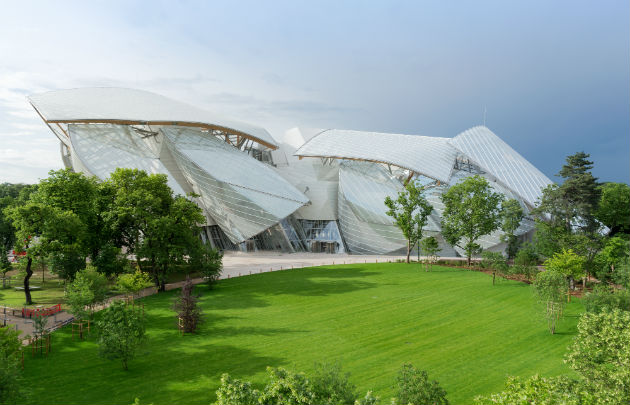
Fondation Louis Vuitton
Philharmonie de Paris
2015
221 Avenue Jean Jaurès, 19th arrondissement
Architect: Jean Nouvel
Constructed from cast aluminum and reflective steel, a shimmering façade made up of 340,000 tiles that depict abstracted birds. Also by Jean Nouvel, 37 Quai Branley (2006) and the Institut du Monde Arabe (1988) with Gilbert Lézénès and Architecture-Studio (1 Rue des Fossés Saint-Bernard), a nod to the greatest structures in the Arab World.
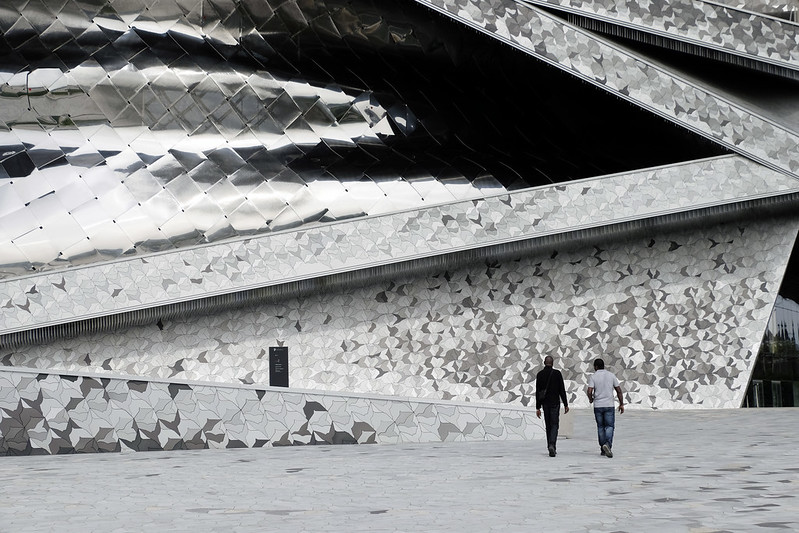
Philharmonie de Paris. Photo credit: Jacqueline ter Haar/ Flickr
Les Choux de Créteil
1966-1974
2 Boulevard Pablo Picasso, 94000 Créteil
Architect: Gérard Grandval
Ten cylindrical buildings each 15 stories in height commonly known as Les Choux (the cabbages). The buildings are a nod to the area which had been used for over 100 years to grow most of the vegetables for Parisian tables.

Les Choux de Créteil. Photo credit: author unknown/ Wikimedia commons
Les Orgues de Flandres
1974-1980
24 Rue Archereau, 19th arrondissement
Architect: Martin van Trek
One of the best examples of Brutalist architecture with its massive design.
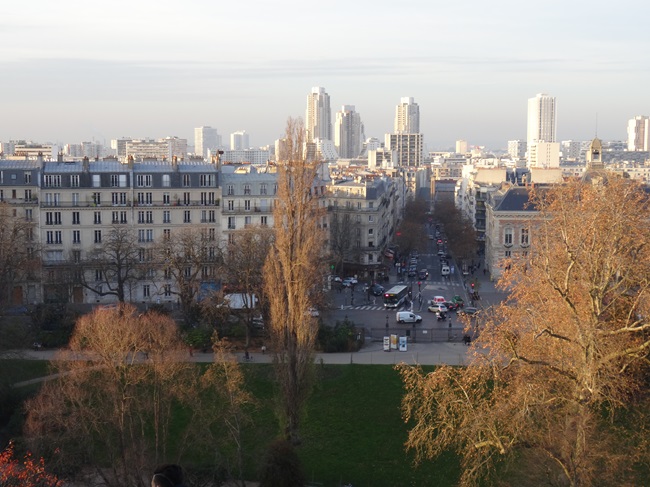
Orgues de Flandre in the background. Photo Credit: Jeanne Menjoulet/Wikimedia Commons
La Seine Musicale
Île Seguin, Boulogne-Billancourt
2017
Architects: Shigeru Ban and Jean de Gastines
The music venues include an elevated egg-shaped auditorium, a modular concert hall, rehearsal rooms and an extensive roof garden. Most of the site’s daytime energy needs are supplied by 10,764 square feet of solar panels that cover a smaller auditorium.
View this post on Instagram
Lead photo credit : View of the principal façade of the Palais Garnier from the Place de l'Opéra, Photo Credit: Peter Rivera/Wikimedia Commons
More in architecture, Paris Buildings



REPLY
REPLY